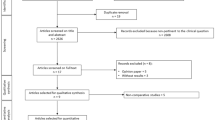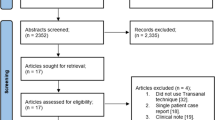Abstract
Turnbull and Cutait described abdominoperineal pull-through followed by delayed coloanal anastomosis (DCA) in 1961. DCA could reduce anastomotic leaks, pelvic morbidity and use of stomas. Strong evidence about its clinical benefits is still lacking. This systematic review examined the clinical outcomes of DCA for the treatment of malignant or benign colorectal conditions. A systematic search of electronic medical databases was conducted. Two independent reviewers selected studies, extracted data and assessed risk of bias. The primary outcome was pelvic morbidity (anastomotic leak, pelvic abscess or sepsis, use of stoma). Fecal continence and survival data were also analyzed. From 1,251 citations, we included seven observational studies including 1,124 patients. All included studies were considered at high risk of bias. Two studies comparing DCA with immediate anastomosis reported a significant decrease in anastomotic leak, and pelvic abscess or sepsis. Low rates of pelvic morbidity were reported in the other five studies: anastomotic leak 0–7 %, pelvic abscess 0–11.8 % and pelvic sepsis 6.8–10 %. Rates of permanent stoma after DCA were low in six studies (1–6 %), with one study reporting an incidence of 25 %. Fecal continence was reported as satisfying in all studies. No differences were observed in a comparative setting. Survival data were reported in four studies. Clinical heterogeneity and methodological issues precluded meta-analysis. Based on retrospective evidence, DCA offers a low rate of anastomotic leak, pelvic morbidity and use of stoma, with reasonable fecal continence. Results are encouraging, but prospective studies are needed for comparison with standard of care.

Similar content being viewed by others
References
Cutait DE, Figliolini FJ (1961) A new method of colorectal anastomosis in abdominoperineal resection. Dis Colon Rectum 4:335–342
Turnbull RJ, Cuthbertson F (1961) Abdominorectal pull-through resection for rectal cancer and for Hirschsprung’s disease. Delayed posterior colorectal anastomosis. Cleve Clin Q 28:109–115
Paun BC, Cassie S, MacLean AR, Dixon E, Buie WD (2010) Postoperative complications following surgery for rectal cancer. Ann Surg 251:807–818
Eriksen MT, Wibe A, Norstein J et al (2005) Anastomotic leakage following routine mesorectal excision for rectal cancer in a national cohort of patients. Colorectal Dis 7:51–57
Longo WE, Virgo KS, Johnson DE et al (1998) Outcome after proctectomy for rectal cancer in Department of Veterans Affairs Hospitals: a report from the National Surgical Quality Improvement Program. Ann Surg 228:64–70
Bell SW, Walker KG, Rickard MJ et al (2003) Anastomotic leakage after curative anterior resection results in a higher prevalence of local recurrence. Br J Surg 90:1261–1266
Baulieux J, Adham M, Nasser Y et al (1996) Anastomose colo-anale différée sans colostomie temporaire de protection pour cancer bas du rectum après radiothérapie pré-opératoire. Lyon Chirurgie 92:87–93
Cutait DE (1970) Prevention of pelvic complications in pull-through operations for cancer and benign lesions. Proc R Soc Med 63(Suppl):121–128
Higgins J, Green S (2008) Cochrane handbook for systematic reviews of interventions. Cochrane book series. Wiley-Blackwell, West Sussex
Jüni P, Witschi A, Bloch R, Egger M (1999) The hazards of scoring the quality of clinical trials for meta-analysis. JAMA 282:1054–1060
The Newcastle–Ottawa scale (NOS) for assessing the quality of nonrandomised studies in meta-analyses. http://www.lri.ca/programs/ceu/oxford.htm. Accessed 16 Aug 2011
von Elm E, Altman DG, Egger M et al (2007) The strengthening the reporting of observational studies in epidemiology (STROBE) statement: guidelines for reporting observational studies. Lancet 370:1453–1457
Stroup DF, Berlin JA, Morton SC et al (2000) Meta-analysis of observational studies in epidemiology: a proposal for reporting. Meta-analysis of observational studies in epidemiology (MOOSE) group. JAMA 283:2008–2012
Baulieux J, Olagne E, De La Roche E et al (1999) Résultats oncologiques et fonctionnels des résections avec anastomose coloanale directe différée dans les cancers du bas rectum préalablement irradiés. Chirurgie 124:240–251
Baulieux J, Mabrut JY, Adham M et al (2004) Conservation sphinctérienne après exérèse des cancers bas du rectum. Stratégie multimodale combinant une radiothérapie pré-opératoire et une anastomose colo-anale différée sans stomie de protection. Bull Acad Natle Méd 188:1509–1524
Chirica M, Parc Y, Tiret E, Dehni N, McNamara D, Parc R (2006) Coloanal sleeve anastomosis (Soave procedure): the ultimate treatment option for complex rectourinary fistulas. Dis Colon Rectum 49:1379–1383
Cutait DE, Cutait R, Ioshimoto M, Hyppólito da Silva J, Manzione A (1985) Abdominoperineal endoanal pull-through resection. A comparative study between immediate and delayed colorectal anastomosis. Dis Colon Rectum 28:294–299
Facy O, Lagoutte N, Jambet S et al (2009) Anastomose colo-anale différée sans stomie de dérivation après résection antérieure basse du rectum. J Chir 146:458–463
Han F, Li H, Zheng D et al (2010) A new sphincter-preserving operation for low rectal cancer: ultralow anterior resection and colorectal/coloanal anastomosis by supporting bundling-up method. Int J Colorectal Dis 25:873–880
Hiranyakas A, Ho Y-H (2011) Laparoscopic ultralow anterior resection versus laparoscopic pull-through with coloanal anastomosis for rectal cancers: a comparative study. Am J Surg 202:291–297
Jarry J, Faucheron L, Moreno W, Bellera CA, Evrard S (2011) Delayed colo-anal anastomosis is an alternative to prophylactic diverting stoma after total mesorectal excision for middle and low rectal carcinomas. Eur Surg Oncol 37:127–133
Jarry J, Faucheron JL (2011) Laparoscopic rectosigmoid resection with transanal colonic pull-through and delayed coloanal anastomosis: a new approach to adult Hirschsprung disease. Dis Colon Rectum 54:1313–1319
Kirwan WO, Turnbull RB Jr, Fazio VW, Weakley FL (1978) Pull-through operation with delayed anastomosis for rectal cancer. Br J Surg 65:689–695
Olagne E, Baulieux J, de la Roche E et al (2000) Functional results of delayed coloanal anastomosis after preoperative radiotherapy for lower third rectal cancer. J Am Coll Surg 191:643–649
Remzi FH, El Gazzaz G, Kiran RP et al (2009) Outcomes following Turnbull–Cutait abdominoperineal pull-through compared with coloanal anastomosis. Br J Surg 96:424–429
Schein CJ, Weiser R (1982) Pull-up technique for low colorectal anastomosis. Surg Gyn Obst 154:567–569
Hüser N, Michalski CW, Erkan M et al (2008) Systematic review and meta-analysis of the role of defunctioning stoma in low rectal cancer surgery. Ann Surg 248:52–60
Chow A, Tilney HS, Paraskeva P, Jevarajah S, Zacharakis E, Purkayastha S (2009) The morbidity surrounding reversal of defunctioning ileostomies: a systematic review of 48 studies including 6,107 cases. Int J Colorectal Dis 24:711–723
Petersen S, Freitag M, Hellmich G, Ludwig K (1998) Anastomotic leakage: impact on local recurrence and survival in surgery of colorectal cancer. Int J Colorectal Dis 13:160–163
Branagan G, Finnis D (2005) Wessex Colorectal Cancer Audit Working Group. Prognosis after anastomotic leakage in colorectal surgery. Dis Colon Rectum 48:1021–1026
McArdle CS, McMillan DC, Hole DJ (2005) Impact of anastomotic leakage on long-term survival of patients undergoing curative resection for colorectal cancer. Br J Surg 92:1150–1154
Walker KG, Bell SW, Rickard MJ et al (2004) Anastomotic leakage is predictive of diminished survival after potentially curative resection for colorectal cancer. Ann Surg 240:255–259
Law WL, Choi HK, Lee YM et al (2007) Anastomotic leakage is associated with poor long-term outcome in patients after curative colorectal resection for malignancy. J Gastrointest Surg 11:8–15
Park IJ (2010) Influence of anastomotic leakage on oncological outcome in patients with rectal cancer. J Gastrointest Surg 14:1190–1196
Heriot AG, Tekkis PP, Constantinides V et al (2006) Meta-analysis of colonic reservoirs versus straight coloanal anastomosis after anterior resection. Br J Surg 93:19–32
Harris GJ, Lavery IJ, Fazio VW (2002) Reasons for failure to construct the colonic J-pouch. What can be done to improve the size of the neorectal reservoir should it occur? Dis Colon Rectum 45:1304–1308
Joo JS, Latulippe JF, Alabaz O, Weiss EG, Nogueras JJ, Wexner SD (1998) Long-term functional evaluation of straight coloanal anastomosis and colonic J-pouch: is the functional superiority of colonic J-pouch sustained? Dis Colon Rectum 41:740–746
Ho Y-H, Seow-Choen F, Tan M (2001) Colonic J-pouch function at six months versus straight coloanal anastomosis at two years: randomized controlled trial. World J Surg 25:876–881
Colorectal Cancer. American Cancer Society. http://www.cancer.org/Cancer/ColonandRectumCancer/DetailedGuide/colorectal-cancer-survival-rates. Accessed 11 April 2012
Visick A (1948) Measure radical gastrectomy: review of 505 operations for peptic ulcers. Lancet 1:551–555
Jorge J, Wexner S (1993) Etiology and management of fecal incontinence. Dis Colon Rectum 36:77–97
Conflict of interest
None.
Author information
Authors and Affiliations
Corresponding author
Appendices
Appendix 1: Search strategy for medline (1966-October 2011)
-
1.
Abdominoperineal pull-through
-
2.
Delayed coloanal anastomosis
-
3.
Delayed colorectal anastomosis
-
4.
Turnbull–Cutait
-
5.
Cutait
-
6.
Endoanal pull-through resection
-
7.
Salvage therapy
-
8.
Salvage therapy (mesh)
-
9.
1 OR 2 OR 3 OR 4 OR 5 OR 6 OR 7 OR 8
-
10.
Rectal resection
-
11.
Abdominoperineal resection
-
12.
Diverting stoma
-
13.
Covering stoma
-
14.
Immediate coloanal anastomosis
-
15.
Total mesorectal excision
-
16.
Surgical stoma (mesh)
-
17.
Suture technique (mesh)
-
18.
10 OR 11 OR 12 OR 13 OR 14 OR 15 OR 16 OR 17
-
19.
Rectal cancer
-
20.
Anorectal disease
-
21.
Anastomotic leak
-
22.
Pelvic abscess
-
23.
Abdominal abscess
-
24.
Fistula
-
25.
Rectovaginal fistula
-
26.
Rectal neoplasm (mesh)
-
27.
Rectal tumor (mesh)
-
28.
Rectal cancer (mesh)
-
29.
Fistula (mesh)
-
30.
Rectal fistula (mesh)
-
31.
Rectovaginal fistula (mesh)
-
32.
Abscess, intra-abdominal (mesh)
-
33.
Anastomosis, surgical (mesh)
-
34.
Anastomotic leak (mesh)
-
35.
19 OR 20 OR 21 OR 22 OR 23 OR 24 OR 25 OR 26 OR 27 OR 28 OR 39 OR 30 OR 31 OR 32 OR 33 OR 34
-
36.
9 AND 18 AND 35
-
37.
Humans (mh)
-
38.
36 AND 37
Appendix 2: Associations considered for meetings’ proceedings review
General surgery
-
American college of surgeons (ACS)
-
European society of surgery (ESS)
-
Canadian association of general surgeons (CAGS)
-
International surgical week (ISW)
-
Society of surgical oncology (SSO)
-
http://www.surgonc.org/meetings-events/annual-cancer-symposium/past-programs.aspx
Colorectal surgery
-
American society of colon and rectal surgeons (ASCRS)
-
Canadian society of colon and rectal surgeons (CSCRS)
-
Meeting combined with the Canadian Surgery Forum (CAGS)
-
European colorectal congress
Rights and permissions
About this article
Cite this article
Hallet, J., Milot, H., Drolet, S. et al. The clinical results of the Turnbull–Cutait delayed coloanal anastomosis: a systematic review. Tech Coloproctol 18, 579–590 (2014). https://doi.org/10.1007/s10151-014-1132-1
Received:
Accepted:
Published:
Issue Date:
DOI: https://doi.org/10.1007/s10151-014-1132-1




